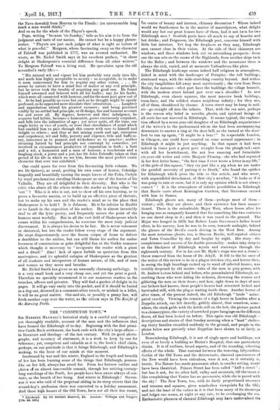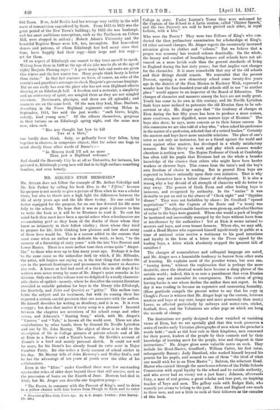THE " CONSPICUOS TOWN."*
SIR HERBERT MAXWELL'S historical study is a careful and competent, yet thoroughly readable, account of the men and the influences that have formed the Edinburgh of to-day. Beginning with the first primi- tive Castle Rock settlement, the book ends with the city's large affairs— in literature and theology—of the last century. With its good photo- graphs, and accuracy of statement, it is a work to keep by one for reference; yet, competent and valuable as it is, the book's chief claim, perhaps, on our gratitude is that it brings Edinburgh, and Edinburgh's making, to the front of our minds at this moment.
Ironbound by war and this winter, England in the length and breadth of her has been learning some of the things that Edinburgh, pennon. like on her hill, always has stood for. From her fortress outline and choice of an almost inaccessible summit, through her 'untiring century- long watchings of the Forth, her people have been aware always of con- teats, as the breath of her being. And winter in Edinburgh ! Steven- son it was who said of the perpetual sliding in its steep streets that the errand-boy's profession there was converted to a holiday amusement. And those high houses of the Old Town, have not all their fine rooms, • Edinburgh. By Sir Herbert Maxwell, Bt, 1.011d0D: Williams and Norgate
flOa. ad. neLl . . .
for centre of beauty and interest, chimney decoration ? Where indeed would we Southerners be in the matter of mantelpieces, what delight would any but our great houses have of them, had it not bean for two Edinburgh men ? Scottish poets have all much to say of hearths and hot drinks ; and Fergusson, the Edinburgh poet, concerns himself with
little but interiors. Yet hug the fireplaces as they may, Edinburgh men cannot close in their vision. At the side of their chimneys are windows, and those windows look out on astonishing prospects—from one the sun sets on the snows of the Highlands, from another ships tack for the Baltic ; and between the windcws and the mountains there is always the rich, varied, and at moments Vallombroa-like plain.
The Edinburgh landscape seems indeed halt religious in atmosphere, linked in mind with the landscapes of Perugino —the tall buildings, straitened ways, with the wide-stretching country beyond. And within the city tangibilities fall away most mysteriously; the view from Dean Bridge, for instance—what part have the buildings, the village beneath, with the modern street behind just over one's shoulder ? In new Edinburgh, even classic squares, the most massive bank buildings, tram-lines, and the solidest stones neighbour infinity ; for they are, all of them, shouldered by chasms. A town street may be hung in mid- air—go straight off into the infinite. That, with the sea mist, perhaps is the reason why belief in wraiths, ghosts, and spiritual beings of all sorts has not wavered in Edinburgh. It seems typical, the explana- tion offered by a seven-year-old daughter of an Edinburgh acquaintance of the writer's to the parlourmaid whom she had been accompanying downstairs to answer a ring at the door-bell, as she turned at the stair- foot to run up again, "It might be a bear!" In respectable London, in Glasgow, one could have counted on some normal appearance ; in Edinburgh it might be just anything. In that square it had been indeed in times past a great poet straight from the plough-tail ; and. with all her bewitchment, the not less amazing and formidable six-year-old writer and critic Marjorie Fleming—she who had reported in her first letter home, " the first time I ever wrote a letter in my life," of the girls of this square, "they cry just like a pig when we are under the painfull necessity of putting it to Death," who found the epithet for Edinburgh which gives the title to this article, and who wrote, with unparalleled detachment, of that city's weather, " It looks as if it was going to rain or snow, but it is only my opinion which is not always correct" ! It is the atmosphere of infinite possibilities in Edinburgh that Barrie casts about Kensington Gardens, that Stevenson carried with him to Samoa.
Edinburgh ghosts are, many of them—perhaps most of them— violent ; still, they are ghosts, and their existence has been unques- tioned. There is the redoubtable Major Weir, whose house after his hanging was so rampantly haunted that for something like two centuries no one dared sleep in it ; and then it was razed to the ground. The Major was hanged in 1670, but Robert Louis Stevenson's father heard often, in his nursery, how he was to be seen, towards midnight, behind the glasses of the Devil's coach driving in the West Bow. Among the most notorious ghosts, too, is Deacon Brodie, well-reputed citizen and Town Councillor by day and burglar by night. His story—the completeness and success of his double personality—makes inky-deep to us the blackness of Edinburgh wynds and stairways through the eighteenth century. For in his case Mr. Hyde's stage was not a stone's- throw removed from the home of Dr. Jekyll. It fell to the lot once of the writer of this review to be in a plague-stricken city, and horror then, in seeing the high hoardings rushed up to ward off infected houses, was terribly deepened by old stories—tales of the men in grey gowns, with St. Andrew's cross behind and before, who perambulated Edinburgh, un- earthing those who were hiding the sickness, drowning the women and gibbeting the men on their doors ; and how, right down to days of men our fathers had known, these people's houses had remained locked and .barricaded still,. with the plague waiting inside them. Another horror of after times, of the present indeed, the old Edinburgh " lands " antici- pated exactly. Viewing the remains of a high house in London after a Zeppelin attack, one felt dazedly, giddily almost, that somehow, some- where, the stark gable with the kettle still on the hob, the picture pasted to a chimney-piece, the variety of wretched paper-hangings on the different floors, all had been looked on before. This again was old Edinburgh— descriptions and stories of that Sunday morning when a "land" shelter- ing thirty families crumbled suddenly to the ground, and people in the plains below saw precisely what Zeppelins have shown to us lately in London.
Remembering Edinburgh, it is not of single spots and buildings, not even of so lovely a building as Heriot's Hospital, that one particularly thinks. It is of outlines, broad aspects, and of the sounding, vibrating effects of the whole. That contrast between the towering, labyrinthine Gothic of the Old Town and the determinate, classical spaciousness of the New would have been ridiculous, were it not, as it certainly is, heroic. For Nature has made panoramic what, in smaller setting, would have been theatrical. Princes Street has been called " half a street " ; but has it not, for its other half, valley and mountain, till the taunt is like complaining that Venice has no pavements, while she is paved with the sky ! The New Town, too, with its finely proportioned crescents and terraces and squares, gives numberless viewpoints for the Old; and not the least of the values in it is that from many of its doorsteps and ledges ono seems, at night at any rate, to .be overhanging the sea. Enthusiastic planners of classical Edinburgh may have undervalued the
Old Town. If so, Auld Reckie had her revenge very swiftly in the wild wave of romanticism engendered by Scott. From 1815 to 1825 was the great period of the New Town's building ; by 1833 she was bankrupt. and her_most ambitious conceptions, such as the Parthenon on Calton Hill, were stopped in mid-air ; Robert Adam's University and the beautiful Register House were left, too, incomplete. But benevolent donors and patrons, of whom Edinburgh has had many since that time, have happily had their copy—their large and fair copy— set for them.
Of an aspect of Edinburgh one cannot to-day trust oneself to speak. Writing from there in 1809 at the age of six (she was to die at the age of eight) Marjorie Fleming says : " A great many bals and routs are given this winter and the last winter too. Many people think beuty is better than virtue." In that last sentence we have, of course, an echo of the cousin's and guardian's attempts to check Marjorie's precocious longings. But no one really has seen the place who has not seen Highland officers Glancing at an Edinburgh ball. A freedom and a restraint, a simplicity and an aristocracy of spirit, are mingled there as they are not mingled elsewhere. Movements, physique, and dress are all splendid ; and manners are on the same level. Of the men they lead, Mme. Duclaux, describing in the Times Highland regiments entering Mclun in September, 1914, has said the just words : "such brave, bright, orderly, kind young men." Of the officers themselves, gorgeous in their tartans on an Edinburgh spring night, and the same men now, when each
" Has nag thought but how to kill Twa at a blow," • one hardly dare think. Only, so gallantly have they fallen, lying together in clusters, in companies almost, that for solace one huge to mind closely those other words of Burns's :— " In Heaven itself I'll ask no more
Than just a Highland welcome."
And should the Heavenly City be at all as Tintoretto, for instance, has pictured it, Edinburgh young men will find in its high outlines something familiar, and even homely.



























 Previous page
Previous page